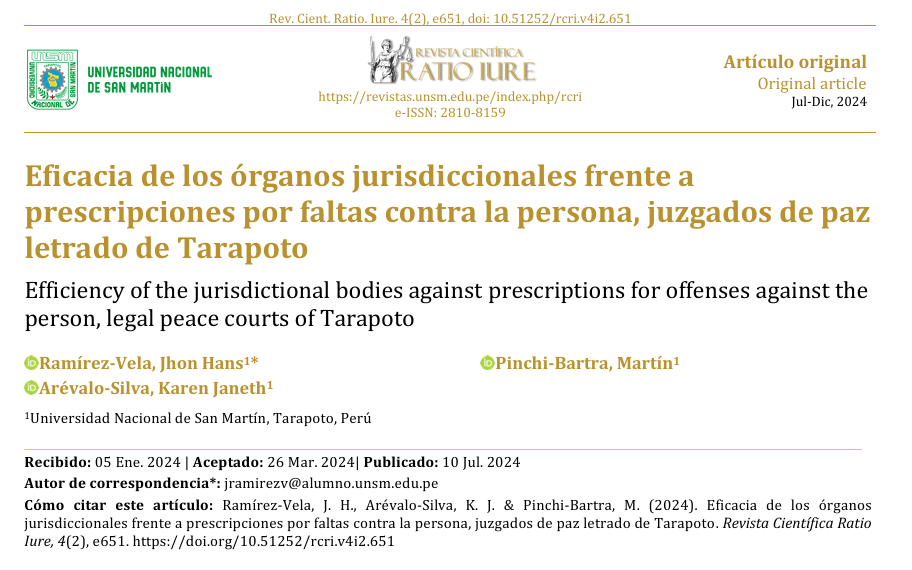Efficiency of the jurisdictional bodies against prescriptions for offenses against the person, legal peace courts of Tarapoto
DOI:
https://doi.org/10.51252/rcri.v4i2.651Keywords:
qualification of claim, tacit withdrawal, determining factors, public policies, reasoning of decisions, rescheduling of hearingsAbstract
The research focuses on the legal formulas derived from the procedural simplification in cases classified as misdemeanors, in which the facts are time-barred due to the passage of time. The general objective was to determine the level of efficiency of the jurisdictional bodies in the face of the statute of limitations for misdemeanors against the person. For this purpose, applied research of quantitative approach was formulated, with a simple descriptive design, non-experimental type, conformed by a population of 31 files in the processes of misdemeanors against the person, of which the totality of the population was taken as a sample, complemented with the participation of 50 experts of the law, following the line of the technique of the documentary analysis guide and questionnaire. The results showed that the level of efficiency of the jurisdictional organs in application to the resolutions of prescription is 72 %, it is acceptable in the procedural decongestion of the courts. It is concluded that the level of efficiency is high since there is an effectiveness of the issuance of the resolutions, therefore, both the delays and the interest of the parties contribute to their prescription, leaving in some cases to be alien to the jurisdictional control itself.
Downloads
References
Bernales Rojas, G. (2007). La Imprescriptibilidad de la Acción Penal en Procesos por Violaciones a los Derechos Humanos. Ius et Praxis, 13(1). https://doi.org/10.4067/S0718-00122007000100009
Chura Sotomayor, W. (2020). A reparación civil cuando la acción penal ha prescrito en aplicación del artículo 12 inciso 3 del código procesal penal. Revista de Derecho, 2(1), 39–46. https://doi.org/10.47712/rd.2015.v2i1.12
Cortez León, V. M. (2021). Caracterización del proceso sobre faltas sobre violencia física Exp. 02190-2016-0-2501-JR-FC-03; Cuarto Juzgado de Paz Letrado, penal Chimbote, distrito judicial del Santa - Perú 2016. [Universidad Católica Los Ángeles Chimbote]. https://repositorio.uladech.edu.pe/handle/20.500.13032/33650
Díaz Castillo, I., & Mendoza Del Maestro, G. (2019). ¿Caducidad o prescripción? De la reparación civil en los casos de sentencias derivadas de procesos penales por delitos contra la Administración Pública en el ordenamiento jurídico peruano. Derecho PUCP, 82, 407–434. https://doi.org/10.18800/derechopucp.201901.014
Farfán Ramírez, F. G. (2021). Teorías de los fines de la pena: la problemática aplicación de la prevención especial en la política criminal peruana. IUS ET VERITAS, 62, 230–252. https://doi.org/10.18800/iusetveritas.202101.013
Fonseca Alarcón, Y. (2019). Ausencia de contumacia en el proceso por faltas y la prescripción de la acción penal. [Universidad César Vallejo]. https://repositorio.ucv.edu.pe/handle/20.500.12692/53921
Hernández Sampieri, R., Fernández Collado, C., & Baptista Lucio, P. (2014). Metodología de la investigación (6ta ed.). McGraw-Hill Education.
Jarama Castillo, Z. V., Vásquez Chávez, J. E., & Durán Ocampo, A. R. (2019). El principio de celeridad en el código orgánico general de procesos, consecuen-cias en la audiencia. Universidad y Sociedad, 11(1), 314–323. https://rus.ucf.edu.cu/index.php/rus/article/view/1127
Jiménez Jara, E. S. (2022). La falta de regulación del plazo de prescripción de la Cobranza de Multas Judiciales, derivada de potestades procesales sancionadoras. La incompatibilidad con los plazos establecidos en el Código Civil Peruano. IUS: Revista de Investigación de La Facultad de Derecho, 10(2), 1–17. https://doi.org/10.35383/ius-usat.v10i2.648
López-Paredes, P., & Gende-Ruperti, C. (2022). Vulneración al derecho del debido proceso: Perspectiva desde los Derechos Humanos en Ecuador. 593 Digital Publisher CEIT, 7(1–1), 724–734. https://doi.org/10.33386/593dp.2022.1-1.1027
Martínez Pardo, V. (2021). La prescripción del delito. Revista Internauta de Pràctica Jurídica(27), 125-142. https://www.uv.es/ajv/art_jcos/art_jcos/num27/4La%20prescripcion%20del%20delito.pdf
Melgar Cucho, J. L. (2022). El ne bis in ídem como principio difuminado en la jurisprudencia penal nacional. Ius Vocatio, 5(5), 71-95. Obtenido de https://doi.org/10.35292/iusVocatio.v5i5.607
Ñaupas Paitán, H., Palacios Vilela, J., Valdivia Dueñas, M., & Romero Delgado, H. E. (2018). Metodología de la Investigación Científica Cuantitativa - Cualitativa y Redac-ción de la Tesis (5th ed.). Ediciones de la U.
Oliver Calderón, G. (2011). Estructura típica común de los delitos de hurto y robo. Revista de Derecho (Valparaíso), 36, 359–395. https://doi.org/10.4067/S0718-68512011000100010
Parra Núñez, F. (2019). Los efectos de la media prescripción penal. Revista de Derecho (Concepción), 87(246), 247–285. https://doi.org/10.4067/S0718-591X2019000200247
Poder Judicial. (2010). Acuerdo Plenario N° 01-2010/CJ-116. VI pleno jurisdiccional de las salas pena-les permanente y transitorias de la Corte Suprema de Justicia de la República. Corte Suprema de Justicia de La República de Perú. https://www.pj.gob.pe/wps/wcm/connect/43131d004075b678b539f599ab657107/ACUERDO_PLENARIO_PENAL_01-2010.pdf?MOD=AJPERES&CACHEID=43131d004075b678b539f599ab657107
Rodríguez Camacho, M. (2018). La defensa penal eficaz como garantía del debido proceso en Ecuador. Revista Universidad y Sociedad, 10(1), 33–40. http://scielo.sld.cu/pdf/rus/v10n1/2218-3620-rus-10-01-33.pdf
Rojas Busellato, D. G. (2023). La Garantía del Plazo Razonable de Duración del Proceso Penal - Pautas para Trazar Límites Temporales y las Consecuencias de su Violación. YachaQ: Revista de Derecho, 15, 23–39. https://doi.org/10.51343/yq.vi15.1165
Salinas Siche R. (2018). Derecho Penal parte especial. Lima: Editorial Iustitia S.AC., 7m ed.
Santana Antezana, M. E. (2021). Independencia y autonomía de la función jurisdiccional en el Distrito Judicial de Junín. [Universidad Peruana los Andes]. https://repositorio.upla.edu.pe/handle/20.500.12848/3156
Valbuena Forero, N. M., & Lombana Buitrago, C. I. (2021). La privatización de la administración de justicia por vía de los mecanismos alternativos de solución de conflictos [Universidad Libre]. https://hdl.handle.net/10901/20537

Downloads
Published
How to Cite
Issue
Section
License
Copyright (c) 2024 Jhon Hans Ramírez-Vela, Karen Janeth Arévalo-Silva, Martín Pinchi-Bartra

This work is licensed under a Creative Commons Attribution 4.0 International License.
The authors retain their rights:
a. The authors retain their trademark and patent rights, as well as any process or procedure described in the article.
b. The authors retain the right to share, copy, distribute, execute and publicly communicate the article published in the Ratio Iure Scientific Journal (RCRI) (for example, place it in an institutional repository or publish it in a book), with an acknowledgment of its initial publication in the RCRI.
c. Authors retain the right to make a subsequent publication of their work, to use the article or any part of it (for example: a compilation of their works, notes for conferences, thesis, or for a book), provided that they indicate the source of publication (authors of the work, journal, volume, number and date).






